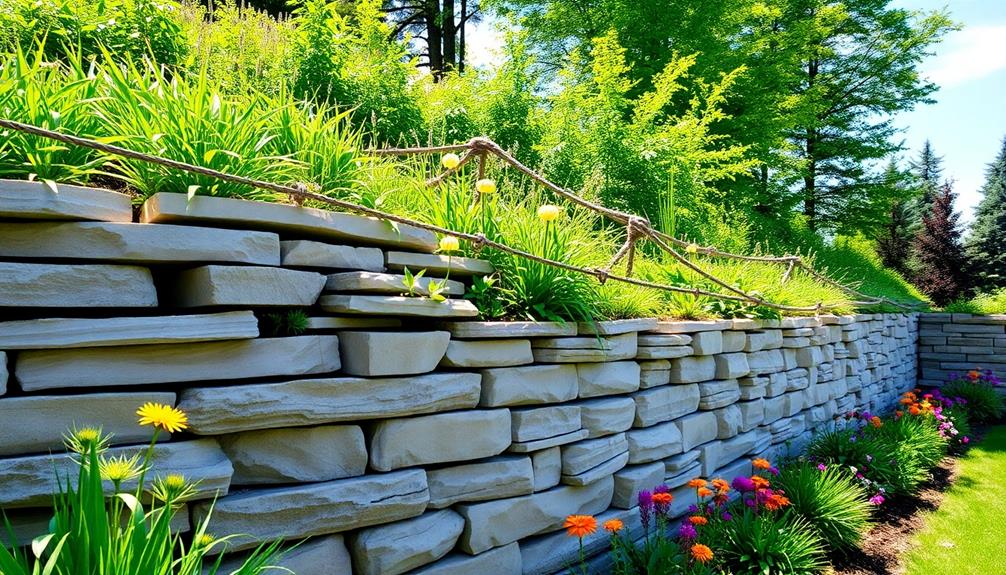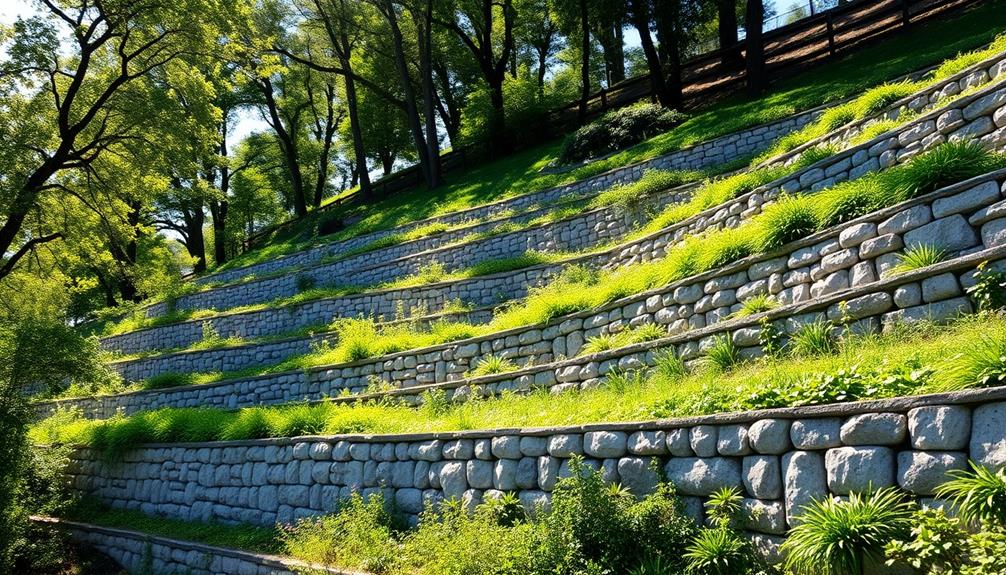Considering environmental impact in retaining wall design is essential for ensuring sustainable practices that conserve ecosystems and promote biodiversity. By evaluating ecological footprints, we account for energy consumption, carbon emissions, and potential effects on local habitats. The use of recycled or locally sourced materials reduces resource depletion and carbon footprint. Incorporating native vegetation and terraced designs enhances habitat creation while supporting natural water management and preventing erosion. These strategies not only reduce maintenance needs but also strengthen community ties, showing a commitment to fostering resilient and ecologically responsible environments. For a deeper understanding of these crucial aspects, explore further insights.
Table of Contents
ToggleWalls Contractor Highlights
- Environmental impact assessment ensures retaining walls are sustainable and minimize ecological harm throughout their lifecycle.
- Sustainable material sourcing reduces carbon footprint and promotes local economies in retaining wall construction.
- Biodiversity strategies enhance local ecosystems and provide habitat connectivity for wildlife and pollinators.
- Efficient water management systems in retaining walls prevent flooding and erosion, protecting infrastructure and natural habitats.
- Implementing eco-friendly practices in retaining wall design contributes to long-term environmental sustainability and community well-being.
Defining Environmental Impact Factors

In the context of retaining wall design, understanding environmental impact factors involves a thorough evaluation of the ecological footprint, ensuring that the materials sourced for construction are sustainable and environmentally responsible. This includes an examination of how the extraction, production, and transportation of materials affect ecosystems, while also considering strategies that prioritize biodiversity conservation in the areas surrounding the construction site.
Expert builders from Granite Company, who have over 20 years of experience, are adept at balancing ecological concerns with their commitment to high-quality construction. By integrating these factors into the design process, engineers can create more sustainable retaining structures that minimize ecological disruption and promote environmental stewardship.
Ecological Footprint Assessment
Amid evolving environmental priorities, evaluating the ecological footprint of retaining wall designs serves as a critical initiative in sustainable engineering. This assessment involves a multidimensional analysis that focuses on quantifying the environmental implications associated with the entire lifecycle of a retaining wall. From design to decommissioning, several factors merit consideration. Energy consumption, carbon emissions, and land use are fundamental components integral to measuring the ecological impact. By understanding these factors, engineers can guarantee that retaining wall projects align with broader sustainability goals, offering environmentally considerate solutions that resonate with community aspirations.
A full ecological footprint assessment also entails scrutinizing the potential impact on local biodiversity. This requires a detailed analysis of how construction activities and the final structure itself might affect flora and fauna in the vicinity. Additionally, water management strategies and sediment control emerge as crucial elements, guarding against unintended negative consequences on local ecosystems. Incorporating innovative technologies and construction practices can drastically mitigate these impacts, reinforcing the ecological equilibrium.
Material Sourcing Sustainability
Evaluating the ecological footprint of retaining walls naturally leads to examining the sustainability of material sourcing. Environmentally conscious design necessitates scrutinizing the origin of materials, as the processes of extraction, processing, and transportation considerably impact ecosystems and carbon emissions. Ensuring that materials are harvested responsibly signifies a commitment to preserving our planet.
To engage with sustainability deeply, consider the following:
- Natural Material Utilization: Selecting materials like rammed earth or recycled concrete can drastically reduce the demand for newly sourced raw materials, lessening the strain on natural resources.
- Local Sourcing: Utilizing locally sourced materials diminishes the carbon footprint associated with transportation, promoting a more sustainable supply chain. It also fortifies regional economies and fosters community resilience.
- Certified Sustainable Suppliers: Partnering with suppliers who uphold sustainability certifications, such as FSC for wood products, guarantees environmental accountability and ethical stewardship in material harvesting.
Incorporating sustainable material sourcing in retaining wall design not only addresses global environmental concerns but also cultivates an ethic of responsibility and community connection. This approach empowers individuals and organizations to contribute meaningfully to environmental preservation, fostering a profound sense of belonging within a movement committed to a sustainable future.
Biodiversity Conservation Strategies
Biodiversity conservation is a pivotal factor in evaluating the environmental impacts of retaining wall design. Acknowledging the intricate web of life that exists within ecosystems, designers must adopt strategies that minimize disruption to local habitats. Retaining walls, while functional in preventing soil erosion and managing landslides, can inadvertently impact native species and plant life. As a result, the integration of biodiversity-sensitive practices in retaining wall projects is essential.
To this end, using native plant species to green retaining walls can enhance local ecosystems and provide indispensable habitats for various organisms. Vegetative coverings not only augment the aesthetic appeal but also support pollinators and strengthen ecological networks.
Additionally, structurally innovative designs such as terraced or stepped walls can create microhabitats that offer refuge to fauna. Emphasizing permeable materials allows natural water filtration, sustaining aquatic life and maintaining natural hydrological cycles requisite for biodiversity.
In collaboration with ecological experts, designers can assess the specific biodiversity challenges and opportunities of each site. This collaborative approach guarantees that all ecological intricacies are considered, enhancing community ties to the natural environment. By prioritizing biodiversity conservation, retaining wall designs serve not only structural needs but also ecological resilience, fostering a deeper sense of connection and responsibility towards our shared ecosystems.
Benefits

Incorporating environmental considerations into retaining wall design can yield numerous benefits, exceptionally through the promotion of sustainable material choices and the encouragement of eco-friendly construction practices, which collectively reduce the carbon footprint and promote resource conservation. By using boulder retaining walls, for example, one can opt for natural materials that boost curbside charm while simultaneously being sustainable and cost-effective.
Additionally, integrating features that support biodiversity, such as vegetation-friendly materials and designs, allows retaining walls to become habitats for various species, thereby enhancing local ecosystems. Additionally, these environmentally-conscious designs can greatly improve water management systems by utilizing permeable structures and integrating natural drainage solutions, consequently mitigating issues such as runoff and erosion.
Promote Sustainable Material Choices
To advance sustainable practices in retaining wall design, the selection of eco-friendly materials is essential. Choosing materials that are not only durable but also environmentally conscious promotes a collective commitment towards preserving natural ecosystems. Such choices underscore a dedication to reducing ecological footprints and protecting the earth for future generations.
By making informed decisions, designers and developers play a significant role in shaping a more sustainable built environment, fostering a sense of unity in achieving common environmental goals.
Incorporating sustainable materials in retaining walls offers several benefits that cater to an environmentally aware clientele:
- Reduced Carbon Footprint: Utilizing materials with lower embodied energy, such as recycled concrete or natural stone, minimizes greenhouse gas emissions, demonstrating a commitment to reducing environmental impacts.
- Enhanced Aesthetic Value: Sustainable materials often blend seamlessly with natural landscapes, enhancing the visual appeal of retaining walls while maintaining harmony with the surrounding environment.
- Longevity and Resilience: Many eco-friendly materials offer increased durability and resistance to weathering, reducing maintenance needs and ensuring the longevity of construction, thereby sparking a sense of pride in robust design choices.
Encourage Eco-Friendly Construction Practices
In addition to selecting sustainable materials, adopting eco-friendly construction practices considerably enhances the environmental benefits of retaining wall projects. By integrating practices such as minimizing site disturbance, construction teams can preserve existing vegetation and soil structure, thereby maintaining the natural habitat and reducing erosion. Implementing efficient waste management systems allows for the recycling of materials, which lessens the burden on landfills and conserves resources. Additionally, choosing low-energy construction techniques, such as manual labor or using machinery with lesser fossil fuel reliance, can dramatically diminish the carbon footprint of the project.
Additionally, utilizing innovations in water management, like permeable surfaces that facilitate groundwater recharge, guarantees that the installation of retaining walls does not adversely impact local hydrology. This focus on sustainable drainage solutions not only supports the environment but also safeguards the structural integrity of the retaining wall by mitigating water pressure-related risks. Engaging in eco-friendly construction aligns with modern values of community and responsibility, providing a shared benefit for the wider ecosystem. These practices embody a conscientious approach that resonates with stakeholders who are committed to preserving ecological balance while achieving their infrastructure goals. In doing so, they contribute to a community grounded in environmental stewardship.
Increase Biodiversity Opportunities
Enhancing biodiversity within retaining wall projects offers numerous ecological and societal benefits. By integrating biodiversity-friendly features, these structures can become thriving habitats that support local ecosystems and community well-being. Establishing green walls and spaces encourages the proliferation of plant species, providing habitats for various fauna, including insects and smaller vertebrates. This, in turn, aids in the urban environment's natural balance, fostering a sense of interconnection among the inhabitants.
The benefits of incorporating biodiversity opportunities in retaining wall designs include:
- Enhanced Ecosystem Connectivity: These structures serve as stepping stones, facilitating the movement of species by connecting fragmented habitats.
- Support for Pollinators: Planting diverse flowering species can support essential pollinators like bees and butterflies, crucial for sustainable horticultural practices.
- Community Well-being: Green spaces promote mental and physical health, offering residents a serene, natural escape within urban landscapes.
Moreover, the inclusion of native plant species in retaining wall designs reduces maintenance needs and supports water conservation, aligning with community-centric ecological goals. Addressing biodiversity proactively not only fulfills an ethical duty but also embodies a commitment to sustainable development, strengthening our shared bonds with nature and each other.
Enhance Water Management Systems
Adopting advanced water management techniques in retaining wall design substantially contributes to environmental sustainability and resilience. Incorporating such systems guarantees a strategic interplay between human-made constructs and natural water cycles, fostering more harmonious ecosystems.
By integrating solutions like permeable backfill or drainage systems, retaining walls can effectively manage stormwater runoff, reducing erosion and sediment transport. This strategic adaptation aids in the conservation of soil quality, while simultaneously supporting healthier aquatic environments downstream.
The enhancement of water management systems within retaining walls is not just an engineering feat but a communal benefit that underscores the symbiotic relationship between built and natural environments. By addressing water management, communities can mitigate risks associated with flooding and waterlogging, ensuring infrastructure durability. It exemplifies how thoughtful engineering can uphold environmental integrity while securing human habitation, creating a sense of place and security.
Furthermore, these water management enhancements work seamlessly with other ecological strategies, such as promoting biodiversity, hence contributing to a more inclusive approach to sustainable urban development. This integration not only reflects an understanding of nature's complexities but also nurtures a fundamental human desire for belonging to a place that is responsibly developed and environmentally conscious.
Soil Erosion Prevention Methods

In the context of retaining wall design, preventing soil erosion is pivotal for environmental sustainability, and several methods have proven effective. Three notable strategies are: utilizing vegetation for erosion control, employing terracing to enhance slope stability, and integrating geotextiles in wall construction. The table below outlines key aspects of these methods:
| Method | Key Aspects |
|---|---|
| Vegetation for Erosion Control | Stabilizes soil and provides habitat support |
| Terracing for Slope Stability | Reduces runoff and soil loss |
| Geotextiles in Wall Construction | Reinforces soil and improves drainage |
These approaches not only mitigate erosion but also align with eco-friendly design principles, benefiting both the built environment and natural habitats.
Vegetation for Erosion Control
When considering soil erosion prevention methods, the strategic use of vegetation emerges as a fundamental approach in retaining wall design. Vegetation inherently stabilizes the soil through root structures that bind the earth, reducing the erosive impact of wind and rain. This natural solution not only enhances the aesthetic appeal of retaining walls but also reinforces soil integrity, fostering a sense of ecological harmony within the landscape.
Incorporating vegetation into retaining wall designs offers numerous benefits that resonate with those seeking both environmental sustainability and community welfare.
- Community Well-Being: A vibrant, vegetative covering can transform retaining walls into visually pleasing green spaces, contributing positively to the aesthetics of shared environments and fostering communal pride.
- Biodiversity Enrichment: Utilizing native plant species supports local ecosystems by providing habitats for wildlife, including essential pollinators, promoting a balanced and thriving ecosystem.
- Cost-Effectiveness: Once established, vegetation reduces maintenance costs compared to hard-engineered solutions by naturally mitigating erosion, thereby ensuring longevity and reducing the need for frequent repairs.
Terracing for Slope Stability
Harnessing the technique of terracing emerges as a formidable solution for enhancing slope stability within soil erosion prevention strategies. This method involves transforming a sloped landscape into a series of step-like horizontal surfaces, effectively reducing runoff velocity and promoting water infiltration. By creating these leveled platforms, terracing minimizes surface erosion and helps to contain soil, thereby stabilizing the slope and protecting valuable land resources. Terracing can be particularly beneficial in areas prone to heavy rainfall and steep gradients, where unchecked soil movement poses significant challenges.
The implementation of terracing aligns with sustainable land management practices, offering both environmental and aesthetic benefits. Terraces can support diverse vegetation, which further bolsters soil integrity through root systems that bind the earth, while enhancing the visual appeal of otherwise barren slopes. Additionally, this approach can foster a sense of community ownership and connection to the land, as it encourages local stakeholders to actively participate in its maintenance and preservation.
Incorporating terracing within retaining wall design not only amplifies slope stability but also underscores a commitment to environmentally conscious construction. Ultimately, terracing serves as an indispensable tool in safeguarding the environment, fostering both ecological balance and community empowerment.
Geotextiles in Wall Construction
Among the various advancements in retaining wall construction, the use of geotextiles stands out for its significant contribution to soil erosion prevention. Designed to reinforce soil structure, these engineered fabrics serve as essential components in modern construction, enhancing both functionality and sustainability.
Geotextiles facilitate water filtration while maintaining soil stability, effectively preventing erosion and promoting environmental resilience. By weaving together natural and synthetic materials, they form a barrier that preserves landscapes and supports structural integrity.
Geotextiles in wall construction present several benefits that resonate with environmentally conscious builders seeking durable solutions:
- Erosion Control: Geotextiles minimize soil displacement by stabilizing slopes, reducing the chances of landslides, and protecting natural habitats from degradation.
- Water Management: Enhancing drainage while maintaining soil integrity, they mitigate water logging and prevent damage to retaining walls, a balance imperative for sustainable development.
- Longevity: Elevating the overall lifespan of retaining structures, geotextiles reduce maintenance needs, ensuring safety and lessening environmental strain.
Incorporating geotextiles into wall construction champions a forward-thinking approach to land management. For communities aiming to safeguard their heritage and foster continuity, reliance on geotextiles affirms a commitment to living in harmony with nature while fostering engineering excellence.
Walls Contractor FAQ
How Does Climate Change Affect the Durability of Retaining Walls?
Climate change exacerbates environmental stressors such as increased groundwater pressure and extreme weather, compromising retaining wall integrity. Enhanced design strategies considering these factors foster resilience, ensuring that structures remain robust and reliable amidst evolving climatic challenges.
Are There Eco-Friendly Materials for Building Retaining Walls?
Yes, there are eco-friendly materials for building retaining walls. Utilizing recycled concrete, sustainably harvested timber, and permeable geotextiles provides environmentally responsible options, fostering a sense of community commitment to sustainable practices in construction and landscape architecture.
How Can Retaining Walls Support Local Biodiversity?
Retaining walls can enhance local biodiversity by incorporating native plants, offering habitats for local fauna, and supporting ecological corridors. Designing with nature in mind fosters community connection, promoting shared responsibility for preserving natural landscapes.
What Are the Cost Implications of Environmentally-Friendly Retaining Wall Designs?
Environmentally-friendly retaining wall designs may require higher initial investment due to sustainable materials and innovative engineering solutions. However, long-term savings can be realized through reduced maintenance, environmental compliance, and enhanced value to eco-conscious communities committed to sustainability.
How Do Retaining Walls Contribute to Reducing Urban Heat Effects?
Retaining walls mitigate urban heat effects by promoting vegetation growth through integrated design features, facilitating natural cooling processes. By fostering biodiversity and reducing heat absorption, these structures contribute to a sustainable and cohesive urban environment.







